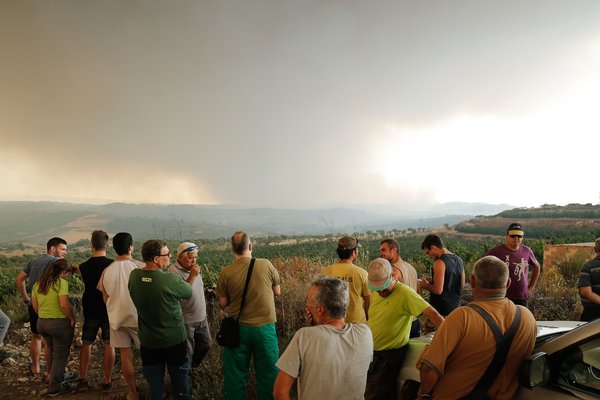Modernity was born 116 years, 11 months, two weeks and two days ago, at a printing plant in the East Williamsburg section of Brooklyn, when a junior engineer named Willis Carrier devised a contraption that blew air over water-filled pipes to dry out the humidity that was gumming up the pages of a humor magazine called Judge.
And in that moment (well, within a few decades), entire industries and geographies were transformed, and new technologies made possible, including, terribly, the internet: Without cooling, there would be no server farms.
Nearly 90 percent of American households now have some form of air-conditioning, more than any other country in the world except Japan, though that will change as global warming alters more temperate zones, and swelling populations and rising incomes in hot zones mean the folks there will clamor for AC, too.
On an overheated planet, air-conditioning becomes more and more desirable, solving in the short term the problem it helped create.
It is another paradox that even as architects and engineers are making ever more efficient buildings to meet energy standards set by cities like New York, where a new law says that buildings over 25,000 square feet must reduce their carbon emissions by 80 percent by 2050, we are still freezing in our offices and fighting with our partners over whether to turn on the Friedrich.
Parts of Germany and France were recently steaming through record temperatures — during last week’s heat wave, police officers in Paris used tear gas on climate change protesters — while I was southbound on Amtrak’s Northeast Regional, shivering in the quiet car, rugged up in a scarf, jacket, long pants and boots.
So were my fellow travelers, like Solange Singer, a 41-year-old fashion stylist muffled in similar gear, with a red wool scarf laid out on her lap like a blanket. The conductor seemed puzzled when I asked him what temperature the thermostat was set to. There is no thermostat, he said: “It’s either off or on.”
Fire, the saying goes, made us human. Does air-conditioning make us less so? In “The Capital,” Robert Menasse’s satirical novel about European Union bureaucrats, published in June, one particularly fastidious character packs cold-weather gear for meetings set in desert nations, “where cold was viewed as a luxury, and luxury as a raison d’être.”
“Think about that term: air-conditioning,” said Mark Feeney, a culture critic at The Boston Globe who suffers at work and does without at home. “Do you want to condition your air? Your skin maybe, or your hair. I’m a vegetarian, but I didn’t become one for any specific reason. It just happened. But there are all sorts of ex post facto good reasons for not eating meat. Same with AC: If you modify your actions, it’s good for the planet, it’s good for everyone. Also, I’m a lapsed Catholic and I’m Irish so I need a certain degree of self-imposed suffering in my life and I guess this qualifies.”
Then he quoted the air-conditioning-averse title character in “Lancelot,” by Walker Percy: “I’d rather sweat and stink and drink ice water.”

CreditGetty Images
“Cooling is the removal of heat, a form of dieting,” Neri Oxman, the computational designer and architect in charge of the Mediated Matter Group at M.I.T.’s Media Lab, said in an email.
She and her colleagues are developing self-cooling building facades and clothing. “Overcooling using conventional AC is extreme dieting, removing calories without improving nutrition,” Dr. Oxman said. “One ends up installing heaters in summer in office spaces that do not enable local temperature control — the quintessential sugar rush. Air-conditioning demystifies nature’s miracles, and contributes to a culture characterized by disconnection and overconsumption.”
At M.I.T., Dr. Oxman’s team is experimenting with polymers and bacteria in the hopes they might “grow” building facades, and “wearables” — clothing, for example — complete with arteries to hold cooled liquids or gas. They can already 3-D-print glass structures with “spatial pockets” designed to be filled with cooling liquid, as well as “biocompatible synthetic skins” for bodies and buildings, Dr. Oxman said, which would “act as thermodynamic, environmentally sensitive filters and barriers” to respond to temperature changes in the environment and self-regulate.
Dr. Oxman, preternaturally gifted, is attempting to make buildings that sweat. But in her own office, she had been flummoxed by the temperature, suffering the icy blasts of summer until she hacked the AC system and dismantled it.
There is an oft-cited study published in Nature.com that notes how building temperatures, once set to the comfort preferences of 1960s-era men in suits, disregard the “thermal comfort” of female staffers.
Come summer, Twitter invariably lights up with charges that air-conditioning is sexist, an engine of the patriarchy, in threads that in turn fire up conservative commentators eager to prove the daftness of the opposition.
Building temperatures are largely controlled by building managers, to industry standards that aim for the thermal comfort of 80 percent of a building’s occupants — which means, of course, that 20 percent will be uncomfortable, if not miserable.
Those standards are updated regularly by the American Society of Heating, Refrigerating and Air Conditioning Engineers, which suggests that building temperatures range from 67 to 82 degrees Fahrenheit and be set according to an enormously complicated calculus.
Among the variables are the number of occupants in the place, what they’re wearing (with values assigned to 17 clothing styles, including sweatpants, miniskirts and bathrobes), humidity, air speed (at one’s ankles) and more. No wonder everyone is caviling; you can’t expect building managers to behave like Stephen Hawking.
Many offices, including those of The New York Times, set their thermostats to 74 to 76 degrees, which you would think would feel balmy (imagine a thermostat set to that temperature during winter). Yet the other day, my colleagues — probably about 20 percent of them — were shivering in sweatshirts and sweaters. (Patrick Whelan, facilities director at The Times, blamed those in the Page One meeting room, who wanted that space to be cooler.)
The Times has a nearly-even gender split; 51 percent of its employees are female. But what of 100 percent female operations? How do they handle their thermostats? At all eight locations of the Wing, the co-working space designed for women, the seating has been fabricated to accommodate a 5-foot-4 woman — the average female height — in soft fabrics, like velvet, anticipating users with bare legs.
In the summer months, temperature is similarly considered: The thermostats are set to 72 to 74 degrees, said Zara Rahim, senior director of communications, a number gleaned from reading studies that suggested men were happier at 70 degrees, and women at temperatures 2.5 degrees higher.
If members are still chilly, there are baskets of knitted cotton blankets placed strategically throughout the club. On a recent visit to the Wing Soho, the place looked like a college dorm during exam week, with some members sitting cross-legged in arm chairs, laptops open, their laps swaddled in blankets.
In 2015, Kieran Timberlake, an architectural firm with more than 100 employees in Philadelphia, tried to work without any air-conditioning at all. The firm renovated a former bottling plant — a concrete and steel warehouse built in 1945 — with many, many design flourishes and technologies, but without modern AC.
Passive and active features provided the cooling, like mechanical and natural ventilation (fans and windows that opened); automated shades; insulation, including a concrete slab floor; and dehumidifiers. The design thinking behind these contemporary refinements has worked for millenniums — imagine an adobe house, or a Roman villa, sealed and shaded against the day’s heat, and opened up at night.
That first summer, however, staffers found themselves increasingly hot, limp and damp, their experience captured by daily surveys that included this plaintive report from one suffering soul: “I am physically melting.”
More fans were brought in, employees were encouraged to work early in the morning — before the day got too hot — and the dress code was relaxed. Clients who visited, including State Department officials (at the time, the firm was working on an American embassy in London) were forewarned. Witold Rybczynski, writing of the experiment in Architect magazine, imagined a scene from a P.G. Wodehouse novel: diplomats in short pants!
It was a grand experiment, and not exactly a failure, since the building, which is now cooled by what’s known as mixed mode operation — that is, using a bit of conventional air-conditioning when needed — is still a model of energy efficiency. Switching to mixed-mode has added only 1 or 2 percent to the building’s total energy load, according to Roderick Bates, a Kieran Timberlake principal.
Mr. Bates said that one of the reasons natural cooling wasn’t fully successful was that Philadelphia’s nighttime temperatures during the peak summer months weren’t low enough to allow natural ventilation to cool the place down. Passive house systems work really well in climates with big diurnal temperature swings, like the desert.
A byproduct of the experiment was the evolution of the survey process, now a cloud-based app called Roast, that revealed something rather illuminating: While there were slightly more survey responses from female staff, the differences in thermal comfort between sexes were insignificant. (Are women just more inclined to participate in surveys?)
It turns out gender is less a predictor of thermal comfort than other factors, like age, activity level or, tellingly, the relative wealth of the society surveyed, according to studies conducted by researchers at the Center for the Built Environment at the University of California, Berkeley.
People in countries with lower G.D.P.s, said David Lehrer, the communications director and a researcher there, are more comfortable with a wider range of temperatures. It appears that first world discomfort is a learned behavior.










